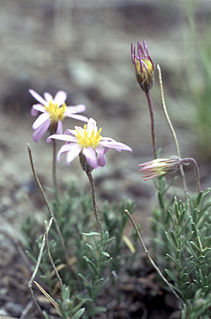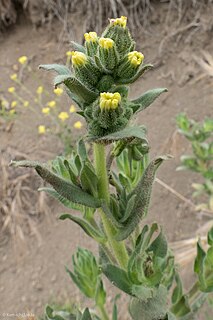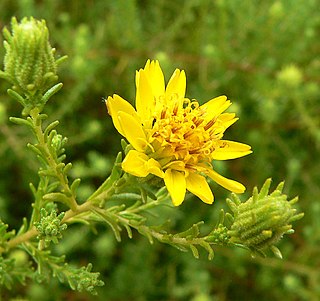
Erigeron foliosus, known by the common names leafy daisy and leafy fleabane, is a North American species of flowering plants in the family Asteraceae.

Eriophyllum confertiflorum, commonly called golden yarrow or yellow yarrow, is a North American species of plant in the family Asteraceae, native to California and Baja California. It has wooly leaves when young, and yellow flower heads. "Eriophyllum" means "wooly leaved."

Hemizonia congesta, known by the common name hayfield tarweed, is a species of flowering plant in the family Asteraceae, native to western North America.

Holocarpha is a small genus of flowering plants in the family Asteraceae. The genus contains four species of tarweeds, which are all endemic to California.

Ionactis alpina is a species of flowering plant in the family Asteraceae known by the common name lava aster. It is native to western United States from California to Montana, where it grows in dry areas.

Blepharizonia plumosa is a California species of tarweed known by the common name big tarweed. It is endemic to central California, where it grows in the Central Coast Ranges and adjacent sections of the southern San Francisco Bay Area and Central Valley, from southern Sonoma County south as far as San Luis Obispo County.

Holocarpha virgata is a species of flowering plant in the family Asteraceae known by the common names yellowflower tarweed, pitgland tarweed, and narrow tarplant.
Harmonia doris-nilesiae is a species of flowering plant in the family Asteraceae known by the common names serpentine tarweed and Niles' madia.

Madia gracilis is a species of flowering plant in the family Asteraceae known by the common names grassy tarweed, slender tarweed, and gumweed madia.

Madia sativa, known by the common names coast tarweed and Chilean tarweed, is a species of flowering plant in the family Asteraceae found in parts of western North and South America.

Blepharizonia is a genus of flowering plants in the family Asteraceae. There are two species, both endemic to California. They are known generally as big tarweeds.

Deinandra conjugens is a rare species of flowering plant in the family Asteraceae known by the common names Otay tarplant and Otay tarweed. It is native to a small section of far northern Baja California in Mexico, its range extending north into San Diego County, California, in the United States. One isolated population has been reported from the hills east of Cayucos in San Luis Obispo County.
Deinandra increscens is a species of flowering plant in the family Asteraceae known by the common name grassland tarweed. It is endemic to California, where it has been found primarily in Monterey, San Luis Obispo and Santa Barbara Counties. A few isolated populations have been reported from Kern and Merced Counties, but these are from urban areas and probably represent cultivated specimens.

Deinandra fasciculata, known by the common names clustered tarweed and fascicled spikeweed, is a species of flowering plant in the family Asteraceae native to western North America.

Deinandra minthornii — — is a rare California species of flowering plant in the family Asteraceae known by the common name Santa Susana tarplant, or Santa Susana tarweed. It is listed as a rare species by the California Department of Fish and Wildlife and on the California Native Plant Society Inventory of Rare and Endangered Plants of California.

Deinandra mohavensis, commonly known as Mojave tarplant or Mojave tarweed, is a species of flowering plant in the family Asteraceae.

Centromadia pungens, the common spikeweed or common tarweed, is a species of North American plants in the tribe Madieae within the family Asteraceae. It is native to northern Baja California and the western United States. The plant is considered a noxious weed in parts of the Pacific Northwest.
Deinandra pentactis, the Salinas River tarweed, is a North American species of plants in the tribe Madieae within the family Asteraceae. It is endemic to California, found in the Coast Ranges of San Benito, Monterey, San Luis Obispo, and northern Santa Barbara Counties.
Deinandra pallida, the Kern tarweed, is a California species of plants in the tribe Madieae within the family Asteraceae. It has been found in the Coast Ranges, southern San Joaquin Valley, and Sierra Nevada foothills in Kern, Los Angeles, Santa Barbara, San Luis Obispo, Tulare, and Kings Counties. Isolated populations have been reported from farther north in Tuolumne County and northwestern Fresno County.
Holocarpha obconica, commonly known as the San Joaquin tarweed, is a North American plant species in the sunflower family. It is endemic to California, primarily in the Central Valley and adjacent regions.















